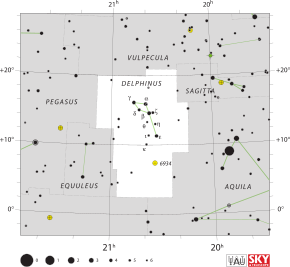
Back Dolfyn (sterrebeeld) Afrikaans الدلفين (كوكبة) Arabic دلفينوس ARZ Delfin (bürc) Azerbaijani Дельфин (йондоҙлоҡ) Bashkir Дэльфін (сузор’е) Byelorussian Дэльфін (сузор’е) BE-X-OLD Делфин (съзвездие) Bulgarian མཚོ་ཕག་སྐར་ཚོམ་ Tibetan Delfin (steredeg) Breton
| Constellation | |
 | |
| Abbreviation | Del |
|---|---|
| Genitive | Delphini |
| Pronunciation | /dɛlˈfaɪnəs/ Delfínus, genitive /dɛlˈfaɪnaɪ/ |
| Symbolism | dolphin |
| Right ascension | 20h 14m 14.1594s to 21h 08m 59.6073s[1] |
| Declination | +2.4021468° to +20.9399471°[1] |
| Quadrant | NQ4 |
| Area | 189 sq. deg. (69th) |
| Main stars | 5 |
| Bayer/Flamsteed stars | 19 |
| Stars with planets | 6 |
| Stars brighter than 3.00m | 0 |
| Stars within 10.00 pc (32.62 ly) | 2 |
| Brightest star | Rotanev (β Del) (3.63m) |
| Messier objects | 0 |
| Meteor showers | None |
| Bordering constellations | Vulpecula Sagitta Aquila Aquarius Equuleus Pegasus |
| Visible at latitudes between +90° and −69°. Best visible at 21:00 (9 p.m.) during the month of September. | |
Delphinus is a small constellation in the Northern Celestial Hemisphere, close to the celestial equator. Its name is the Latin version for the Greek word for dolphin (δελφίς). It is one of the 48 constellations listed by the 2nd century astronomer Ptolemy, and remains one of the 88 modern constellations recognized by the International Astronomical Union. It is one of the smaller constellations, ranked 69th in size. Delphinus' five brightest stars form a distinctive asterism symbolizing a dolphin with four stars representing the body and one the tail. It is bordered (clockwise from north) by Vulpecula, Sagitta, Aquila, Aquarius, Equuleus and Pegasus.
Delphinus is a faint constellation with only two stars brighter than an apparent magnitude of 4, Beta Delphini (Rotanev) at magnitude 3.6 and Alpha Delphini (Sualocin) at magnitude 3.8.
- ^ a b "Delphinus, Constellation Boundary". The Constellations. International Astronomical Union. Retrieved 15 July 2020.